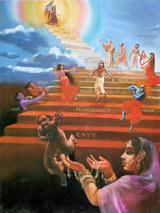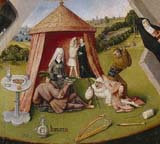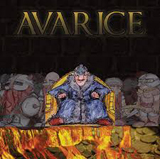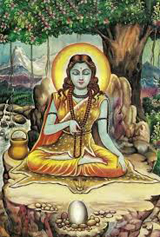Consciousness and health
The wheel of lower life
Abstract
Any attempt to move towards human well-being will be grossly inadequate if we do not address the issue of negative emotions. Yogic science describes six such emotions as the principal enemies and they are known as the Ariṣaḍvargas. One can ask, if they are so detrimental, why should Nature create them and preserve them? There was an evolutionary necessity. They provided a help for survival, but are an obstacle to the growth into the higher consciousness. This article vividly describes the hidden role of these negative emotions from an evolutionary perspective.
The evolutionary stride that nature has drawn for life to flourish on earth can also be followed from biological and psycho-analytical perspectives. And so it is a common observation that human beings and animals exhibit similar emotions. The difference between human beings and animals lies in the fact that the human mind can translate emotions into thoughts and words and thereby give these emotions a capacity to live for a longer time, whereas animals soon live out their emotions and fall into a kind of amnesia, typically tamasic, where they seek similar fresh emotions. (tamas is the principle of inertia, the other two principles being rajas or the principle of energy and sattva or the principle of equilbrium between the two tending towards Light. All these three principles become operative only when they are joined together by the Supreme Will acting on the universal consciousness. Food and sex, the two basic instincts, play an important role in weaning out the old emotions and seeking fresh ones.
In yoga, these negative emotions are classified into six categories:
Kāma or lust,
Krodha or anger,
Lobha or avarice,
Moha or infatuation,
Mada or egocentricity, and
Mātsarya or envy.
These are called Ariṣaḍvargas or the six enemies to spiritual progress in yoga.
All these negative emotions can be traced back to one or other kind of fear and all fears are rooted in their grand cause, the fear of death. Though they are called negative, as they seriously retard mental refinement, Nature devised them for a purpose that is quite different and utilitarian. These emotions help to protect an animal from becoming bankrupt of food and shelter and save itself from death. When understood closely, the lower nature allows and encourages animals to indulge in these negative emotions in order to forget the fear of death for the time being. These are the forces that foster ego and bring out the growth of various facets of personality through clash, strife and competition. That is how the lower nature, with its animalistic behaviours and instinctual responses, has been built and effectively operated even before man with his abilities of mind came into existence and displaced animals to a lower rung of evolutionary order.
The higher order of life or higher life is imbued with the advantages of fine-tuned expressions which assure emotional stability and time-tuned processes which assure life beyond death. The lower order of life or lower life cares little for finer emotions or refinement of emotions and death is an inevitable process and a challenge out of which life has to pass through and prove victorious if it has to sustain. Man cannot have the advantage of living a higher life just because he is born as a man. He has to pass through the lower life or the life of an animal before he affirms and puts to full use the components of his mind and wins over the lower nature.
A human being who is attached to food and sex has no other way than to live the life of an animal bound to Ariṣaḍvargas and enjoys these emotions in an animalistic way. Animal life invests a major part of its vitality in these activities, which are regulated completely by the nature with the least possibility for individual interference. As long as individuality is not built and exercised, the Ariṣaḍvargas protect and uphold the being from death and destruction. By exercising the higher faculties of reason or viveka, memory or bodhana and discrimination or buddhi, man has to grow out of these negative emotions and live in peace, freedom and love. Yoga or the ancient wisdom suggests various means to achieve this transformation of the lower life into a higher life.
In yoga, Ariṣaḍvargas are used to explain all perverse psychology. Even the cause of a physical disease can be explained and its cure possible when one can comprehend the occult neuro-chemical changes that support these emotions. When one meditates on each of these emotions, one can see the obvious chain-like succession that continues between these emotions and all other variables of emotions fit into one or other categories of these chief emotions. It is interesting to find that the animal or human being is attached to the instincts of food and sex as long as they live the lower life but abstains from them when he is caught by a sublimated or positive emotion. Indulgence in food and sex can benumb and degrade one`s emotional sensibility and behaviour and bring oneself closer to matter, whereas sublime emotions can take us to the heights of life and cherish noble thinking. In yoga, the negative emotions of lower life are turned into levers to positive emotions of love, courage, equanimity, aspiration, gratitude and peace once the emotional identification with the instincts of food and sex are overcome.
Kāma or lust is the desire for possession of a thing or sexual enjoyment. On the subconscient level, the sexual urge translates itself into egoistic assertion and satisfaction of possessing a thing and thus desire of all kinds is considered as kāma. This emotion is cunningly explosive and is a never-ending process trickily put into living beings by Nature itself in order to use them as tools to achieve certain distant goals. Its chief purpose is prolongation of life of the race or the species and the building up of improvised models with changed patterns to survive the struggle for existence and provide life with a sense of comfort at the expense of other things or beings. It brings in distant inputs for growth and packs them into too tiny corpuscles of energy which spurt out at the least sensual contact of a vacuum that can take out or offer life in a moment. The fission of bacteria or virus or the meiosis of a spore or a seed or a gamete, which are the seasonal schisms that may end in death or lead to perennial multiplication or mitosis, are the result of kāma. Though the origin of kāma is in the superconscient and is meant for the noble cause of the protection of species, its action proceeds straight into the inconscient and its effects take shape in the subconscient. All the qualities of lower life starting from micro-organisms and parasites (called udbhija, born from earth, i.e. through simple fission), sea algae and amphibian plants (swedaja- born from sweat, i.e. from the initial occurrence of water on earth), terrestrial plants and egg-laying animals (anḍaja-seed born, i.e. life is transported to distant places for replication), and evolved animals or mammals (jaraayuja-born with ability to move, i.e. the sense of right movement is given in the womb itself) are packed in the form of genes and split into appropriate patterns to manifest that strata of life are provoked as a result of kāma.
The energy that sustains this ‘emotion of schism’ is of a very high order which can destroy the very roots of existence or recreate endlessly and often carelessly with little respect to an aesthetic sense by using any amount of physical material that is available. Even a little amount of this energy, when misused, can prove detrimental to the very existence of the animal as it exhausts the chief source of vitality and the animal often becomes a prey to it unless this emotion is moderated or totally overcome. Often this emotion is considered as equivalent to pleasure and indulgence in it is accepted as a relief from stress. But the risk of running into grave dangers of evil and subconscient memories soon surfaces as a threat to the life-process by creating confusion between the forms of replication from one form to other. When it is palpably present, the animal grows restless and gradually gets frustrated and this leads to krodha or anger. One can infer that when anger is strong, there must be some desire unfulfilled.
At the animalistic level, krodha or anger is the chief means to overpower and it is easily used as a means to achieve a goal or attain control over other animals. Those who express anger or rage have the advantage of growing powerful in the group they live in and that is why this emotion is skilfully indulged in for all bad causes. As it is with all other negative emotions, anger by itself is not bad and often it is the justifiable way of expressing one`s frustration over things or events that do not heed the need for change or become obstacles to change. In cases where no ill-will or bad desire is palpable behind this emotion, it is the revolt of rajas over tamas such that sattva can retain its noble place in the transitional time-frame. It sends shudders along the nerves and the energy explodes in the internal and external environment at once. In the order of evolution, this is the chief emotion which differentiates the animal kingdom from the plant kingdom.
Whereas kāma is cunningly explosive, krodha is truly explosive. krodha is the only emotion which cannot be cunningly hidden by whatever amount of suppression or repression and pure anger is next to universal love in its spiritual chastity. Animal rage or aggression is equally admirable as an integral expression of Nature`s beauty but in human beings, its virtuous use lies only as an impetus to grow out of tamas into sattva and rajas. It has to be an expression of Kaali over the obstacles that impede spiritual growth or an expression of Rudra which permanently destroys menacingly awkward behaviours. Otherwise, it can behaviourally reduce the status of man to a beast. When krodha is harnessed into energy or is sublimated into obstinate dexterity and courage, it can achieve goals that are otherwise impossible.
Lobha or avarice is a natural successor of anger, as whatever is achieved through anger has to be gathered and stored so that it will be out of reach of other animals or persons. Avarice is a covert emotion. It is never overtly expressed and it always chooses a substitute among the five other emotions to express itself. Lobha or avarice has the ability to pin down the being to tamas. One who is overpowered by lobha thinks that it is to the peace and calmness of sattva that he is clinging and not to the inertia of tamas. While krodha is radical cutting out from Rajas, lobha is tenacious sticking to tamas because of the fear of total destruction. The positive side of this emotion is that it can withstand the scorching fire of rajas and save the being from total annihilation. This emotion counterbalances krodha and thus becomes a natural successor to krodha as it is only in this way the existence can survive after a fit of exhaustive loss because of krodha.
Moha or infatuation is the preoccupation of the mind or of the whole being with a thing that it possesses. It is the fourth negative emotion in the order of emotions starting from kāma and if it can be called sublimation, this emotion is a sublimatory transition from sexual urge where the desired thing is an abstract and wild pleasure to an overpowering craving for the less abstract and less obnoxious things without which life considers itself to be lifeless. Moha helps a person to get identified with the thing before him and pushes him to the extremes of his energies till it is achieved. Though it is not an achievement in itself, the person overpowered by moha does not understand it to be so. It is a faulty identification of oneself with the objects or situations or persons around and this happens when ego starts to take shape. Thus this emotion is a prelude to the formation of ego, an essential shift from the Muladhara cakra to the Swadhitana cakra. When concentrated in the Muladhara cakra, a person considers himself to be one amongst all and feels nothing special or important about him and he has too much competition before him in order to exceed others. But in the Swadhistana, the person starts to feel that he is special and does things to make him appear special and is never happy to share his seat with others.
Kāma, krodha and lobha are the fuels to this trend and moha is the starting-point of the exhibition of this trend. As the expression of kāma is denoted by a cunning explosion, krodha by its overt explosion and lobha by its covert attitude, moha may be called an implosion because the person under the effect of this emotion becomes weak-minded and unable to memorise, analyse or discriminate as he comes across the thing with which he is infatuated. As long as one is infatuated, one loses control over thinking and the capacity for making decisions is benumbed. The Bhagavat Gita points out this orderly succession of emotions as a passing-by remark.
Mada or egocentricity is the fifth negative emotion and its chief feature is aggrandisement of the ego. The person under the influence of his ego begins to see nothing but himself everywhere around and thus he builds his own world of imaginations and he carries it with him all the time in his active and passive modes (jagratha and swapnaavasthas). The faulty identification of moha carries itself further to give rise to faulty analysis of mada. Due to the loss of reasoning capacity, the person is prone to all kinds of delusions. It may look strange but it is interesting to notice that it gives a sense of fulfilment and achievement to a person happily caught in the lower nature because there is nothing that can oppose him in his imaginary world and even his blunders are excused in the name of unavoidable circumstances. The lower world proudly celebrates the existence of such egocentric persons and these achievements are considered as benchmarks for success in life. Naturally they pursue their works with a sense of dexterity and do not hesitate to prey upon their inferiors in order to survive. They disrespect the boundaries that are meant to protect and organise an orderly higher life and they feel truthfulness as incapacity and a great threat to their existence.
Mātsarya or envy is a natural consequence of egocentricity. The person under the influence of mātsarya begins to hate everyone and sees perversities around him. This is a phase of defeat of mada or egocentricity. He thinks that others are planning conspiracies in order to prove that he is always wrong and he is thus busy in self-justification all the time. It is a necessary outcome of excess of ego and the damage that is caused by mātsarya on the mind lasts longer than all other emotions. When all other emotions have a tendency to represent themselves as diseases of the physical body, mātsarya has its effects more on the mind than on the body. Only a selfless love that is greater than the ego can heal the wounds caused by the destruction of ego. A person is unintentionally attracted to the spiritual life because of mātsarya, as he feels a dearth of love everywhere in the lower nature. If not attracted so, he would live with a mental derangement of varying intensities. If he is happy to live longer in the lower nature, he is engaged in fresh expressions of kāma and krodha and so on.
The advantage that mātsarya gives to a person or animal is that it prevents him from falling into the trap of adversaries. A deeper fear of self-annulment prevents the ego from destroying itself and so all modes of protection are fully utilised by these people or animals and they tend to react even before they are attacked. An amount of stress is generated because of excessive diversion of energy for self-protection. This stress is generated even because of the other five emotions but this becomes overtly visible in the phase of mātsarya. When this stress is not properly dissipated, it can build up as pressure in some part of the body and this can damage the natural balance on mental, vital, physical or biochemical level.
Mātsarya is the first instinctual line of defence that differentiates life and inert matter. The second line of defence is pain. The instinctual solace from these reactions comes from attraction towards the opposite sex and the search for food. A group reaction of this emotional insecurity is war-mood. A strong and unalterable sense of duality is the hallmark of Ariṣaḍvargas. This game of Life is all about one`s survival at the cost of other`s life. Before the life is lost, the being wants to enjoy Ānanda rasa or the nectar of ecstasy in whichever form it is hidden in the guise of matter before it is possessed by another being. As long as the five senses do not convey the unitary experience that fills the gulf between the mind or manas and universal consciousness or citta, the fight between the egos cannot stop and the sense of duality re-enters within seconds as the touch of universal consciousness recedes back, leaving the senses separated and split. Any amount of pacifying, caressing, convincing are temporary moral or ethical methods characteristic of mind and so cannot change this vital attitude. The only solution lies in restoring the ego to its place of prestige and putting it back in an atmosphere where it can grow further by the affirmation of self through the strength of ego into a state of egolessness and selflessness. The emotional transformation that takes place through proper alignment of ego with the neighbouring egos is the life of a family. Caste, community, religion and nation are synonymous to the sense of belonging which is typical to family. Caste, community, religion and nation remain synonymous to the sense of belonging which is typical to a family as long as the higher life, which is organised around the sense of sacrifice for the cause of oneness does not balance the inequality between the senses.
Ego represents the external atmosphere of the self or the surface self and it builds the external nature matted with disequilibriant and erratic proportions of the panchamahābhūtas. Once this external growth reaches a zenith, the disequilibrium becomes more and more conspicuous, forcing the nature to go within. This is the time for the quest of the inner self or the psychic being. In order to go deeper, the external pressure dissolves the ego and makes the inner journey easier. This is the order of evolution. Thus a rational understanding of the behaviour of Ariṣaḍvargas allows us to attune the external with the internal environment and spiritual growth becomes an inevitable step in the process of evolution.
Dr. Venkatesh Palla, a member of SAIIIHR, is a practising homoeopathic physician at Bhimavaram, Andhra Pradesh, India.
Share with us (Comments,contributions,opinions)
When reproducing this feature, please credit NAMAH,and give the byline. Please send us cuttings.








